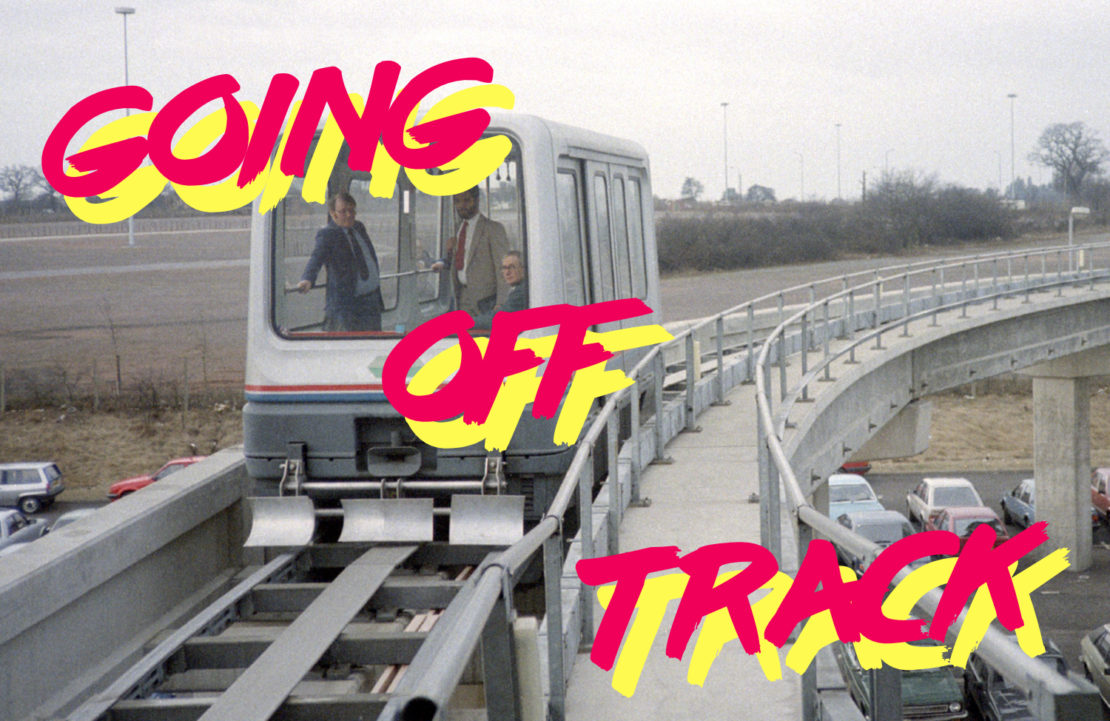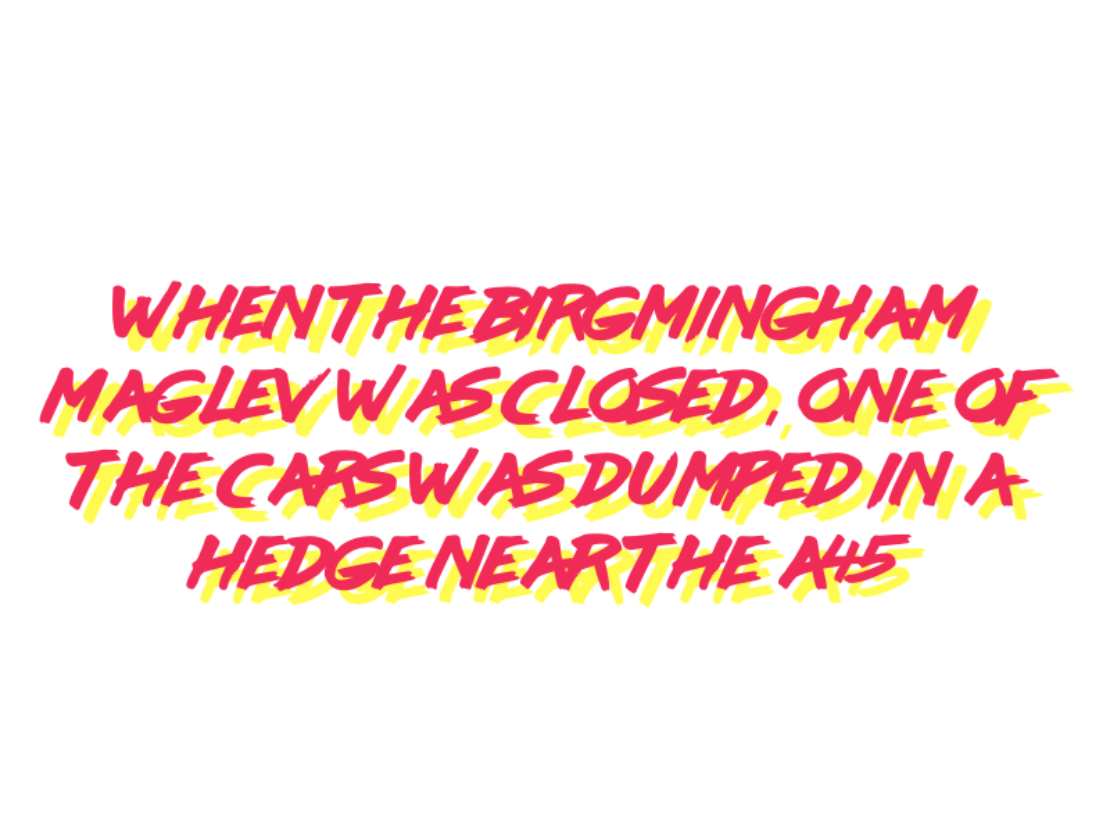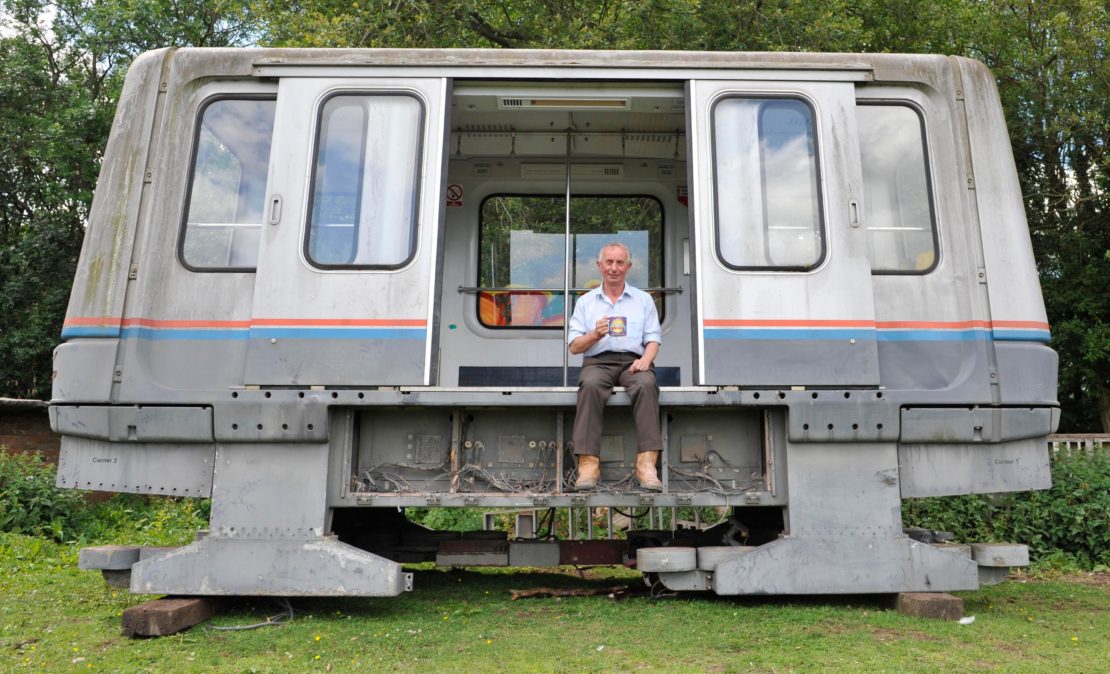
Going off track
Birmingham's airport isn't like other airports. Right at the north-western end of runway 15 there's a country park and a row of benches. You'll see families picnicking here, enjoying the subsonic spectacle of planes from Brussels, Bucharest and Barcelona roaring just feet overhead on their final approach. Birmingham isn't like other British cities – it fetishises the technical and promotes the new. It is unstinting in its thrall to evolution and unsentimental about erasing past versions of the future in its rush to create new ones; the comprehensive 1960s vision of the city which itself swept away a century's Victoriana is currently being meticulously taken apart concrete slab by concrete slab. The city's motto is 'Forward'.
When you get to a certain age you realise how much more visions of the future say about the present they're concocted in than the actual future they purport to show us hurtling towards. A track in the air, sitting on top of concrete legs that couldn't look any more like rational new humans striding into a technocratic promised land if they tried, will always evoke a kind of nostalgia for the 20th century. You think of the SAFEGE monorail depicted in Truffaut's 1966 film adaptation of Fahrenheit 451; and of regional news reporters with greasy barnets delivering excited pieces to camera about big plans.
Today, on the elevated track that gambols over windswept car parks and threads through cheap motels between Birmingham's airport terminal and the railway station, a simple, ski resort-style people-mover system ferries passengers from plane to train. Three decades ago it was so much more exciting: the world's first commercial maglev, or magnetic levitation, system ran along here.
Opened in 1984, the Birmingham Maglev came at the very tail end of a trente glorieuses for British transport technology and, more broadly, European engineering; an era that promised so much yet eventually bequeathed so many relics and ruins.
The modernism of the 20th century, expressed especially in architecture and engineering, seemed like nothing less than the founding of a new order. Progress was to be continual, unstoppable and good. Yet today the physical and philosophical advances are being gradually taken apart and retracted, as if we'd woken up sweating and feared we'd somehow overreached ourselves.
When the Birmingham Maglev was shuttered in 1995, one of the cars was dumped in a hedge near the A45. Furniture maker and transport enthusiast Andy Jones splashed out a mere £100 for it on eBay in 2011 (although, he says, "it cost me £400 to get it out of the hedge!"). Now it sits in a field behind Jones's house in Burton Green, a couple of miles east of the airport in the rolling Warwickshire countryside.

I reminisce to Jones about my boyhood excitement for the Birmingham Maglev, about the silly enthusiasm I felt when I got to go on it in the late 80s. He shared the experience. "I used it in the old days too," he says. "I'd ride backwards and forwards on it, I thought it was smashing."
"The problem was, it was the end of one lot of technology. The first time it snowed, all hell broke loose! It had a ratcheting mechanism, a primitive form of winch. Beneath that was the hydraulic system. It was lifted up by the magnetic field (under the [car] are steel sheets). But you'd use the hydraulic system to pull it back up on to the system if it broke."
Bob Gwynne, associate curator of collections and research at the National Rail Museum in York, says: "British Rail's Derby Research Centre, founded in 1964, was arguably the world's leading rail research facility when it was in full operation. An understanding of the wheel and rail interface comes from there, as does the first tilting train, a new railbus, high-speed freight wagons, computer-controlled interlocking of track and signal, the first successful maglev and many other things." Gwynne has got the second of the three Birmingham Maglev cars at the museum.
The maglev was a development that spun out of this research at Derby, and developed in a joint project with a private consortium that included the now-defunct General Electric Company. The maglev cars were built by Metro Cammell at its factory four miles from the airport in Washwood Heath. It was the same place many tube carriages came from, and if you look down the doors on Piccadilly line carriages as you get on and off, you can see a cheery 1973 plaque reminding travellers of this fact (the cheeky Brummie assumption here being that London commuters always look at the floor).
But the British maglev never really took off. Tim Dunn, transport historian and co-presenter of the BBC's Trainspotting Live, explains why. "The early 80s was still a time of great British national-funded engineering," he says. "Success at Birmingham Airport would have been a great advert for British Rail Engineering Limited (BREL) to sell maglev internationally. (Remember that BREL was always trying to sell its technology overseas, which is why several Pacer trains, developed on bus bodies, were sold to Iran.) Birmingham's Maglev only lasted 11 years: replacement parts were getting hard to obtain for what was really a unique system. Buses took over, and eventually a cable-hauled SkyRail people-mover was installed atop the piers. That's not as exciting for people like me, who like the idea of being whisked in a hovertrain pushed along by magnets. But then our real transport future always has been a pretty crap approximation of our dreams."
Sign up to our newsletter
You don't have to look far to find other relics of this white-hot time when post-war confidence begat all sorts of oddities. There's the test track for the French Aerotrain outside Orleans – a rocket-powered prototype that never made it to middle age. And in Emsland, the German conglomerate Transrapid built a 32km supersized test track for their maglev, which seemed to be on course for success. A variation of this train shuttles passengers from Shanghai to the airport, and the plan was to copy the same model in Munich, and even build an intercity line from Berlin to Hamburg. Today the test track stands idle awaiting its fate, while the Transrapid vehicles are up for auction; a museum in Erfurt is trying to save the latter from the scrapyard. Little remains of Germany's other maglev, the M-Bahn (or Magnetbahn), a short-lived shuttle service that ran in West Berlin from 1989-91 connecting stations whose service had been previously severed by the Berlin Wall. With the Wall gone, the old U-Bahn service was reinstated and the M-Bahn, which had run along its tracks, disappeared from the capital of the new Germany.
"The problem with high-speed maglev like Transrapid in Germany," says Tim Dunn, "is that it doesn't really stack up against high-speed rail. It's more expensive, it's lower capacity, it's more complex. There's a gap in the market, but there's no market in the gap. What is needed generally in mass transit is more capacity, rather than super high speed."
But back in the post-war period, we thought we could have everything. Britain's tertiary science departments expanded. We built the Comet jetliner, then Concorde; and concrete buildings to house them that the world envied, like the huge Heathrow hangar that Sir Owen Williams, primarily an engineer, designed for BOAC's planes; and architect James Stirling's much-lauded engineering faculty at Leicester University. Yet a little-known footnote from this period involves the interaction of magnets in high-speed train design with that other British invention that prevailed for a while but then seemed to peter out: the hovercraft.
"We have always wanted to get rid of wheels," says Railworld's Brian Pearce. "One invention [to this end] was Chris Cockerell's hovercraft." At the same time, maglev technology was being developed by the British inventor, Eric Laithwaite, who was working on the linear induction motor at Imperial College when he found a way for it to produce lift as well as forward thrust. The two systems were combined to form a tracked hovercraft. "So along came RTV31," says Pearce. "The train rode along the track on a cushion of air created by big electric fans. Not very energy efficient! The forward motion was created by a linear motor, which moved along rather than going round and round."

RTV31 could, like France's Aérotrain or the German Transrapid system, have been a viable new form of intercity travel. But funding was insufficient throughout the project and eventually Britain pulled the plug. In February 1973, a week after the first test RTV31 hovertrain reached 157km/h, the project was abandoned as part of wider budget cuts.
There's an eerie reminder of the RTV31 in the big-skied, liminal lands of East Anglia. The train was tested on a track that ran up alongside the New Bedford River at Earith in Cambridgeshire: appropriate, because this 'river' is actually a supreme piece of man-made engineering from an earlier age, a dead-straight dyke dug by Dutchman Cornelius Vermuyden to drain the fens in the 1600s. The RTV31 test-track piers endure as further reminders of a past future. The vehicle itself sits not far away at Peterborough's Railworld, where its colourful exterior is strikingly visible to today's travellers on the East Coast Main Line from London to Scotland. Its neighbour is the final redundant Birmingham Maglev car.

In the far east, attitudes to maglev are different. Japan began maglev testing at roughly the same time as Britain in 1962 and is today building the longest, fastest maglev in the world. It will run mostly in tunnel, at 500km/h, taking a shocking 40 minutes to travel the 300km between Tokyo and Nagoya. It's been christened the Chūō Shinkansen: just another, faster type of bullet train for the central districts. Japan's system is a superconducting maglev, different to the Birmingham and German systems. It uses superconducting coils in the train, which cause repulsion to move the train forward. The Japanese also use wheels for the vehicle to 'land' on the track at low speeds.
It's understandable that most serious interest in maglev deployment is in Asia – Japan, China, India," says John Harding, former chief maglev scientist for the US Department of Transportation. "This is understandable wherever passenger traffic is huge and can dilute the enormous capital cost. (Maglev is indisputably more expensive upfront than high-speed rail.) Even for California, which has huge air passenger traffic between LA and San Francisco, there is nowhere near enough demand to justify maglev; probably not enough to justify high-speed rail. But the Chūō Shinkansen will probably be the greatest success for maglev." The first link between Tokyo and Nagoya is scheduled to begin operation in 2027. Then the Chinese are proposing a 600km/h system between Shanghai and Beijing.
Most read
Why the world wide web will break up Is there such thing as a 'criminal' face? What lettuces tell us about deregulating BritainSo there are still some people dreaming big. The latest iteration of this is of course Hyperloop, whose vacuum tube technology harks back to another British engineering innovation: the atmospheric railway, which was developed by Henry Pinkus, the Samuda Brothers and eventually by Isambard Kingdom Brunel. This technology used varying air pressure to suck trains up a track in a partial vacuum. Lines popped up in London, Dublin and most notably Brunel's South Devon Railway, where the pipes were plagued by nibbling rats but the pumping stations survive as relics of Victorian visionaries. If those systems looked like something from HG Wells, with men in top hats smoking cigars, then Hyperloop, with its internet age funding from Tesla founder Elon Musk, could well end up appearing as a very 2010s caper when we look at back on it from the distance of decades. Or maybe Hyperloop will revolutionise travel like maglev was supposed to.
Back in Burton Green, Andy Jones's maglev car lies in limbo. "I'd like to build a platform around it," he says, "turn it into a playhouse for the grandchildren perhaps? A couple of people want to take it away and turn it into a cafe." Perversely perhaps, its fate may be decided by another type of transport technology: more conventional high speed rail. The route for the much-disputed High Speed 2 line from London to Birmingham slices right through the field where the maglev car sits.
In the 2000s the UK Ultraspeed proposal was floated to link London, Birmingham, the North and Scotland by maglev. It never materialised. HS2 was the eventual successor to the Ultraspeed plan, though a less futuristic one. Jones has another idea for his forward moving relic: "Maybe I'll turn it into viewing platform, so you could watch HS2's outdated technology."